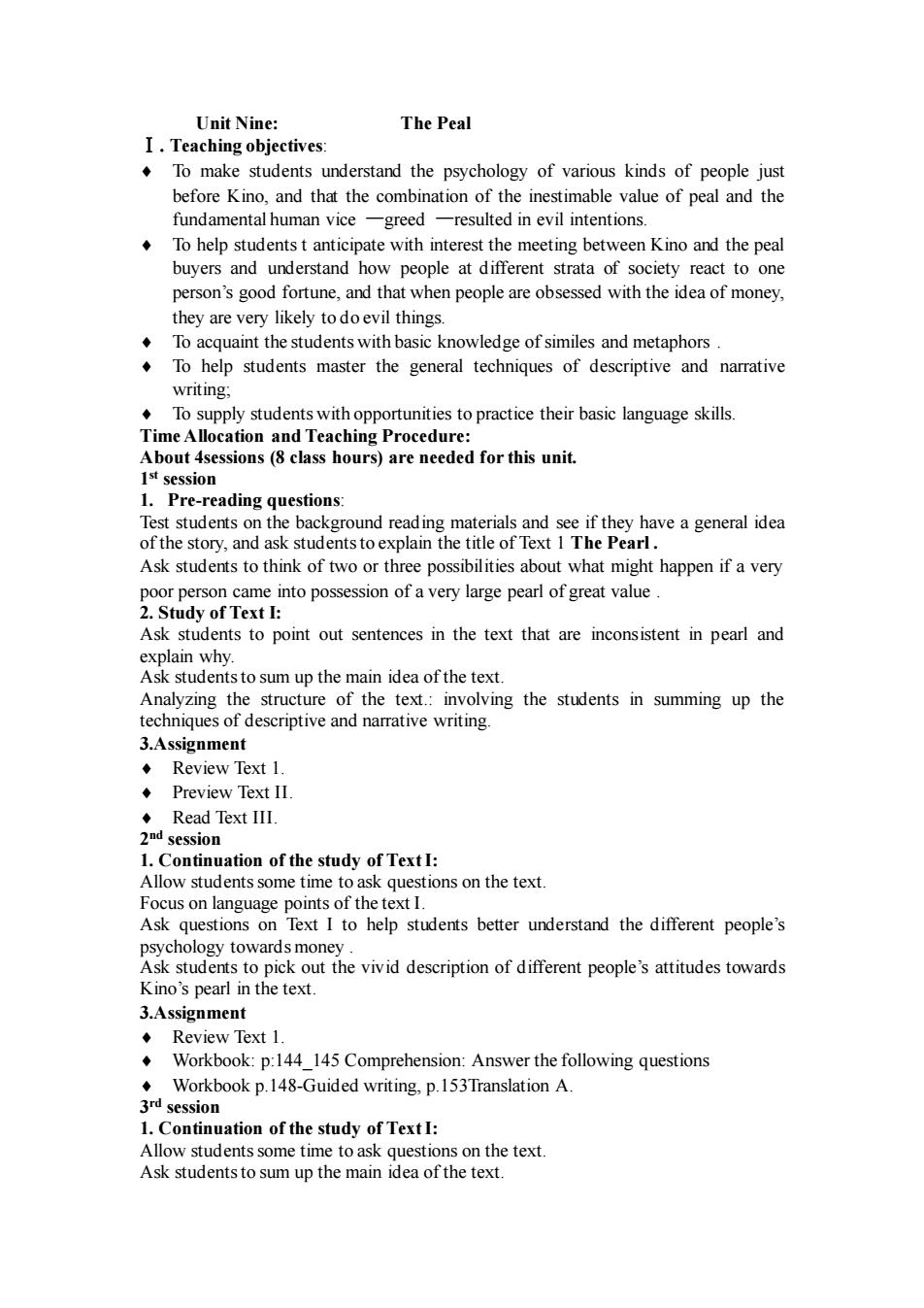
Unit Nine: The Peal I.Teaching objectives: To make students understand the psychology of various kinds of people just before Kino,and that the combination of the inestimable value of peal and the fundamental human vice -greed -resulted in evil intentions. To help students t anticipate with interest the meeting between Kino and the peal buyers and understand how people at different strata of society react to one person's good fortune,and that when people are obsessed with the idea of money they are very likely todoevil things To acquaint the students with basic knowledge of similes and metaphors To help students master the general techniques of descriptive and narrative writing; To supply students with opportunities to practice their basic language skills Time Allocation and Teaching Procedure About 4sessions(8 class hours)are needed for this unit. Ist session 1.Pre-reading questions: Test students on the background reading materials and see if they have a general idea of the story,and ask students to explain the title of Text 1 The Pearl. Ask students to think of two or three possibilities about what might happen if a very poor person came into possession of a very large pearl of great value 2.Study of Text I: Ask students to point out sentences in the text that are inconsistent in pearl and explain why. Ask students to sum up the main idea of the text. Analyzing the structure of the text.:involving the students in summing up the techniques of descriptive and narrative writing. 3.Assignment ◆Review Text1 ◆Preview Text IⅡ Read Text II ation of the udy of TextI the questions on the text. A on Text I to help students better understand the different people's he vivid description ofrpeople'sattitudes towards Kino's pearl in the text. 3.Assignment Text 1 Workbook:p:144 145 Comprehension:Answer the following questions Workbook p.148-Guided writing,p.153Translation A. 3rd session Continuation of the study of Text I: Allow students some time to ask questions on the text Ask students to sum up the main idea of the text
Unit Nine: The Peal Ⅰ.Teaching objectives: To make students understand the psychology of various kinds of people just before Kino, and that the combination of the inestimable value of peal and the fundamental human vice —greed —resulted in evil intentions. To help students t anticipate with interest the meeting between Kino and the peal buyers and understand how people at different strata of society react to one person’s good fortune, and that when people are obsessed with the idea of money, they are very likely to do evil things. To acquaint the students with basic knowledge of similes and metaphors . To help students master the general techniques of descriptive and narrative writing; To supply students with opportunities to practice their basic language skills. Time Allocation and Teaching Procedure: About 4sessions (8 class hours) are needed for this unit. 1 st session 1. Pre-reading questions: Test students on the background reading materials and see if they have a general idea of the story, and ask students to explain the title of Text 1 The Pearl . Ask students to think of two or three possibilities about what might happen if a very poor person came into possession of a very large pearl of great value . 2. Study of Text I: Ask students to point out sentences in the text that are inconsistent in pearl and explain why. Ask students to sum up the main idea of the text. Analyzing the structure of the text.: involving the students in summing up the techniques of descriptive and narrative writing. 3.Assignment Review Text 1. Preview Text II. Read Text III. 2 nd session 1. Continuation of the study of Text I: Allow students some time to ask questions on the text. Focus on language points of the text I. Ask questions on Text I to help students better understand the different people’s psychology towards money . Ask students to pick out the vivid description of different people’s attitudes towards Kino’s pearl in the text. 3.Assignment Review Text 1. Workbook: p:144_145 Comprehension: Answer the following questions Workbook p.148-Guided writing, p.153Translation A. 3 rd session 1. Continuation of the study of Text I: Allow students some time to ask questions on the text. Ask students to sum up the main idea of the text
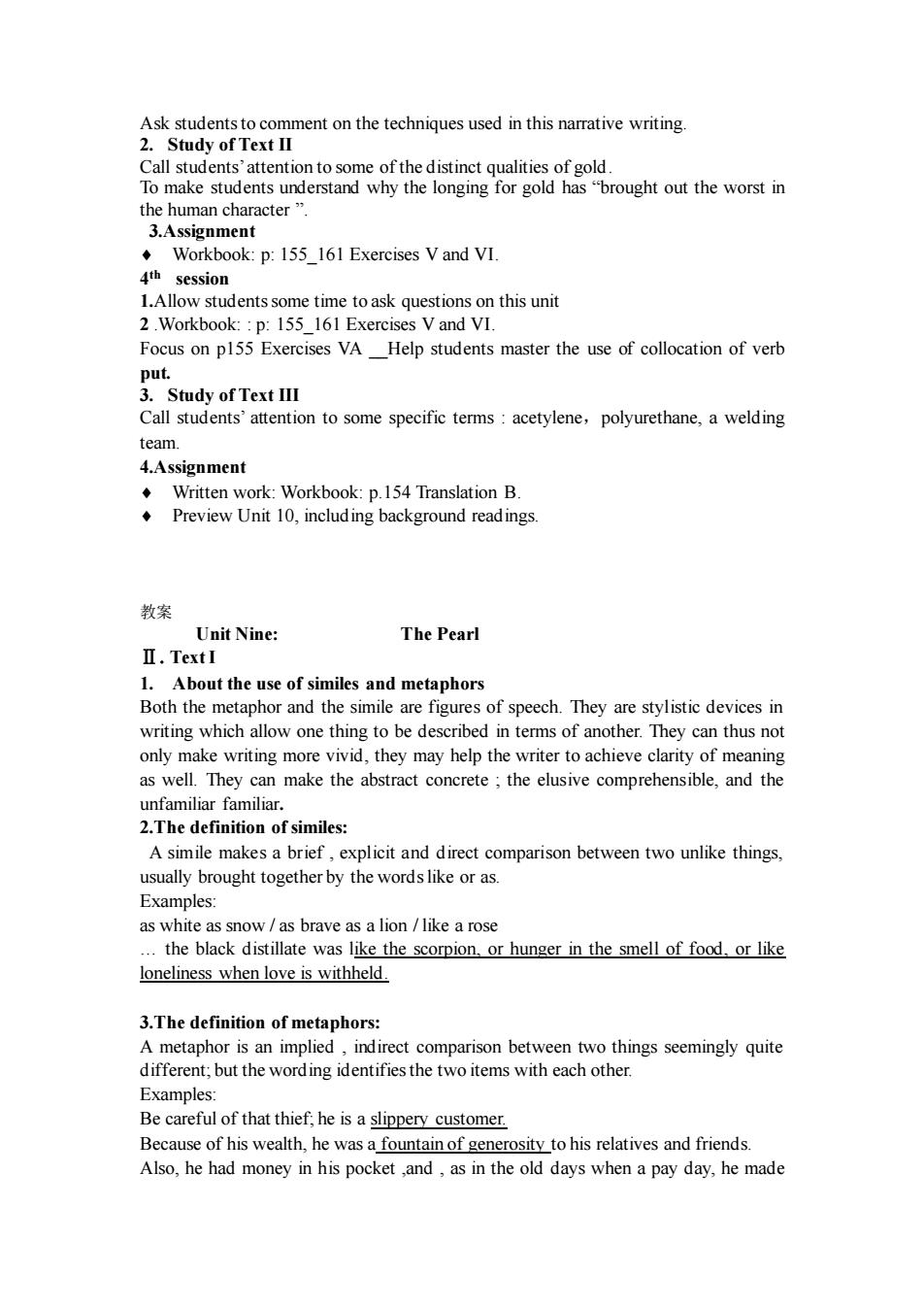
Ask students to comment on the techniques used in this narrative writing. 2.Study of TextⅡ Call students'attention to some of the distinct qualities of gold To make students understand why the longing for gold has"brought out the worst in the human character". 3.Assignment Workbook:p:155 161 Exercises V and VI. 4th session 1.Allow students some time to ask questions on this unit 2.Workbook:p:155 161 Exercises V and VI. Focus on pl55 Exercises VA Help students master the use of collocation of verb Study of Text III Call students'attention to some specific terms acetylene,polyurethane,a welding team 4.Assignment Written work:Workbook:p.154 Translation B. Preview Unit 10,including background readings 教案 Unit Nine: The Pearl Ⅱ.TextI sand metaphors oun ee ures of pec They rtte deve writing which allow one thing to be described in terms of another.They can thus not only make writing more vivid,they may help the writer to achieve clarity of meaning as well They can make the abstract concrete:the elusive comprehensible.and the nfamiliar familiar 2.The definition of similes A simile makes a brief,explicit and direct comparison between two unlike things, usually brought together by the words like or as. Examples: as white as snow /as brave as a lion/like a rose the black distillate as like the e scorpion,or hunger in the smell of food or like loneliness when love is withheld 3.The definition of metaphors: A metaphor is an implied,indirect com differen ntif the items v ith Examples Be careful of that thief;he is a slippery customer. Because of his wealth,he was a fountain of generosity to his relatives and friends. Also,he had money in his pocket,and,as in the old days when a pay day,he made
Ask students to comment on the techniques used in this narrative writing. 2. Study of Text II Call students’attention to some of the distinct qualities of gold. To make students understand why the longing for gold has “brought out the worst in the human character ”. 3.Assignment Workbook: p: 155_161 Exercises V and VI. 4 th session 1.Allow students some time to ask questions on this unit 2 .Workbook: : p: 155_161 Exercises V and VI. Focus on p155 Exercises VA _Help students master the use of collocation of verb put. 3. Study of Text III Call students’ attention to some specific terms : acetylene,polyurethane, a welding team. 4.Assignment Written work: Workbook: p.154 Translation B. Preview Unit 10, including background readings. 教案 Unit Nine: The Pearl Ⅱ.Text I 1. About the use of similes and metaphors Both the metaphor and the simile are figures of speech. They are stylistic devices in writing which allow one thing to be described in terms of another. They can thus not only make writing more vivid, they may help the writer to achieve clarity of meaning as well. They can make the abstract concrete ; the elusive comprehensible, and the unfamiliar familiar. 2.The definition of similes: A simile makes a brief , explicit and direct comparison between two unlike things, usually brought together by the words like or as. Examples: as white as snow / as brave as a lion / like a rose . the black distillate was like the scorpion, or hunger in the smell of food, or like loneliness when love is withheld. 3.The definition of metaphors: A metaphor is an implied , indirect comparison between two things seemingly quite different; but the wording identifies the two items with each other. Examples: Be careful of that thief; he is a slippery customer. Because of his wealth, he was a fountain of generosity to his relatives and friends. Also, he had money in his pocket ,and , as in the old days when a pay day, he made

the money fly Focus: A metaphor is a figure of speech in which one thing is described in terms of another.A comparison is usually implicit;whereas in simile it is explicit. Examples: He is a mule.(metaphor) He is stubborn like a mule.(simile) II.Teaching Points in Text 1 1.available-to be able to be had,obtained,used seen,etc. The only means of transport available in that area were donkeys. To save the life of the little boy stung by a scorpion,the villagers used all the means and ways available. 2.as to-(used esp.when speaking of arguments and decisions)on the subject of concerning As to how the splendid Maya Culture disappeared all of a sudden from the earth,it remains a mystery hard to solve. He's very uncertain as to whether it's the right job for him 3.it is made plain that-it is made clear that When it is made plain that it was a big rat that had caused the breakdown of the transmission system,we all felt relaxed. 4.in the way-to stop or delay the advance or development of (a person or activity) Am I in your way? If you are not going to help,at least don't get in the way 5.semblance-an appearance bear the semblance of an angel and the heart of a devil put on a semblance of shyness He always makes semblance as if he were busy. 6.give a semblance of-have an appearance of He wanted to give semblance of benevolence.(仁爱,善行) 7.all manner of-every kind of,all sorts of,many different types of All manner of measures have been taken to improve the emergency treatment service in that hospital They asked me all manner of questions 8.stir up (a feeling)-cause trouble or cause people to have the feeling stir up great public concern
the money fly. Focus: A metaphor is a figure of speech in which one thing is described in terms of another. A comparison is usually implicit; whereas in simile it is explicit. Examples: He is a mule. (metaphor ) He is stubborn like a mule. (simile) Ⅲ. Teaching Points in Text 1 . 1. available—to be able to be had ,obtained ,used ,seen, etc. The only means of transport available in that area were donkeys. To save the life of the little boy stung by a scorpion, the villagers used all the means and ways available. 2. as to—( used esp. when speaking of arguments and decisions) on the subject of ; concerning As to how the splendid Maya Culture disappeared all of a sudden from the earth, it remains a mystery hard to solve. He’s very uncertain as to whether it’s the right job for him. 3. it is made plain that —it is made clear that When it is made plain that it was a big rat that had caused the breakdown of the transmission system, we all felt relaxed. 4. in the way—to stop or delay the advance or development of (a person or activity) Am I in your way? If you are not going to help, at least don’t get in the way. 5. semblance—an appearance bear the semblance of an angel and the heart of a devil put on a semblance of shyness He always makes semblance as if he were busy. 6. give a semblance of—have an appearance of He wanted to give semblance of benevolence. (仁爱,善行) 7. all manner of— every kind of , all sorts of , many different types of All manner of measures have been taken to improve the emergency treatment service in that hospital. They asked me all manner of questions. 8. stir up (a feeling)—cause trouble or cause people to have the feeling stir up great public concern
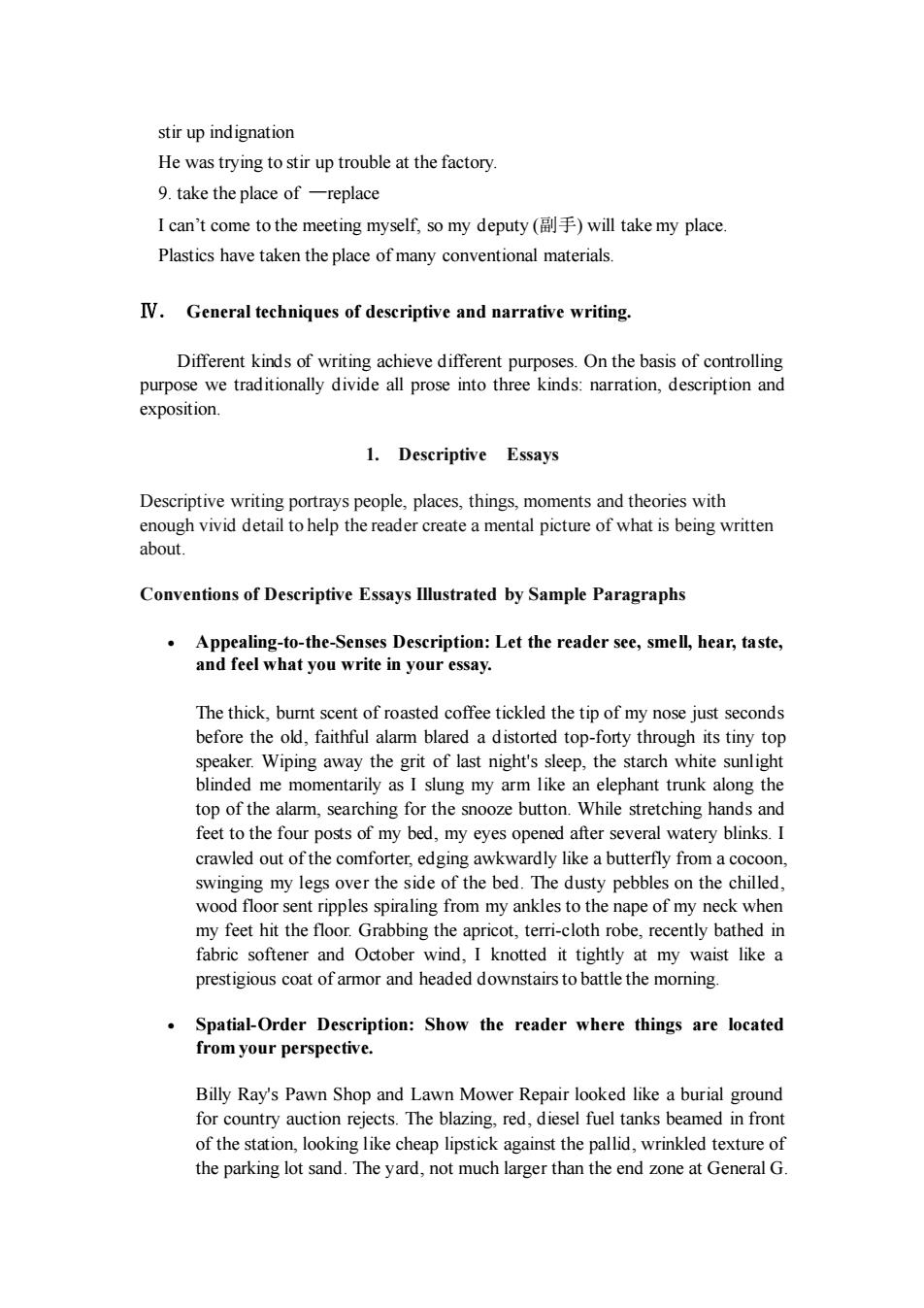
stir up indignation He was trying to stir up trouble at the factory 9.take the place of-replace I can't come to the meeting myself,so my deputy (will take my place. plastics have taken the place of many conventional materials. IV.General techniques of descriptive and narrative writing. Different kinds of writin g achieve different purp es.On the basis of controlling purpose we traditionally divide all prose into three kinds:narration,description and exposition. 1.Descriptive Essays Descriptive writing portrays people,places,things,moments and theories with enough vivid detail to help the reader create a mental picture of what is being written about. Conventions of Descriptive Essays Illustrated by Sample Paragraphs Appealing-to-the-Senses Description:Let the reader see,smell,hear,taste, and feel what you write in your essay. The thick.burnt scent of roasted coffee tickled the tip of my nose just seconds before the faithful aa op gh its tiny top Wiping away the gn of last night's cep,the sunligh me momentarily as I slung my arm like an elephant trunk along the top of the alarm.searching for the snooze button.While stretching hands and feet to the four posts of my bed,my eyes opened after several watery blinks.I crawled out of the comforter,edging awkwardly like a butterfly fromaco my legs o er the id e the bed.The du usty pe on the chilled wo ent ripples spir raling from my ankles to e nape of my nec my feet hit the floor.Grabbing the apricot,terri-cloth robe,recently bathed in fabric softener and October wind,I knotted it tightly at my waist like a prestigious coat of armor and headed downstairs to battle the morning. Spatial-Order Description:Show the reader where things are located om your perspec Billy Ray's Pawn Shop and Lawn Mower Repair looked like a burial ground for country auction rejects.The blazing,red,diesel fuel tanks beamed in front of the station,looking like cheap lipstick against the pallid,wrinkled texture of the parking lot sand.The yard,not much larger than the end zone at General G
stir up indignation He was trying to stir up trouble at the factory. 9. take the place of —replace I can’t come to the meeting myself, so my deputy (副手) will take my place. Plastics have taken the place of many conventional materials. Ⅳ. General techniques of descriptive and narrative writing. Different kinds of writing achieve different purposes. On the basis of controlling purpose we traditionally divide all prose into three kinds: narration, description and exposition. 1. Descriptive Essays Descriptive writing portrays people, places, things, moments and theories with enough vivid detail to help the reader create a mental picture of what is being written about. Conventions of Descriptive Essays Illustrated by Sample Paragraphs • Appealing-to-the-Senses Description: Let the reader see, smell, hear, taste, and feel what you write in your essay. The thick, burnt scent of roasted coffee tickled the tip of my nose just seconds before the old, faithful alarm blared a distorted top-forty through its tiny top speaker. Wiping away the grit of last night's sleep, the starch white sunlight blinded me momentarily as I slung my arm like an elephant trunk along the top of the alarm, searching for the snooze button. While stretching hands and feet to the four posts of my bed, my eyes opened after several watery blinks. I crawled out of the comforter, edging awkwardly like a butterfly from a cocoon, swinging my legs over the side of the bed. The dusty pebbles on the chilled, wood floor sent ripples spiraling from my ankles to the nape of my neck when my feet hit the floor. Grabbing the apricot, terri-cloth robe, recently bathed in fabric softener and October wind, I knotted it tightly at my waist like a prestigious coat of armor and headed downstairs to battle the morning. • Spatial-Order Description: Show the reader where things are located from your perspective. Billy Ray's Pawn Shop and Lawn Mower Repair looked like a burial ground for country auction rejects. The blazing, red, diesel fuel tanks beamed in front of the station, looking like cheap lipstick against the pallid, wrinkled texture of the parking lot sand. The yard, not much larger than the end zone at General G
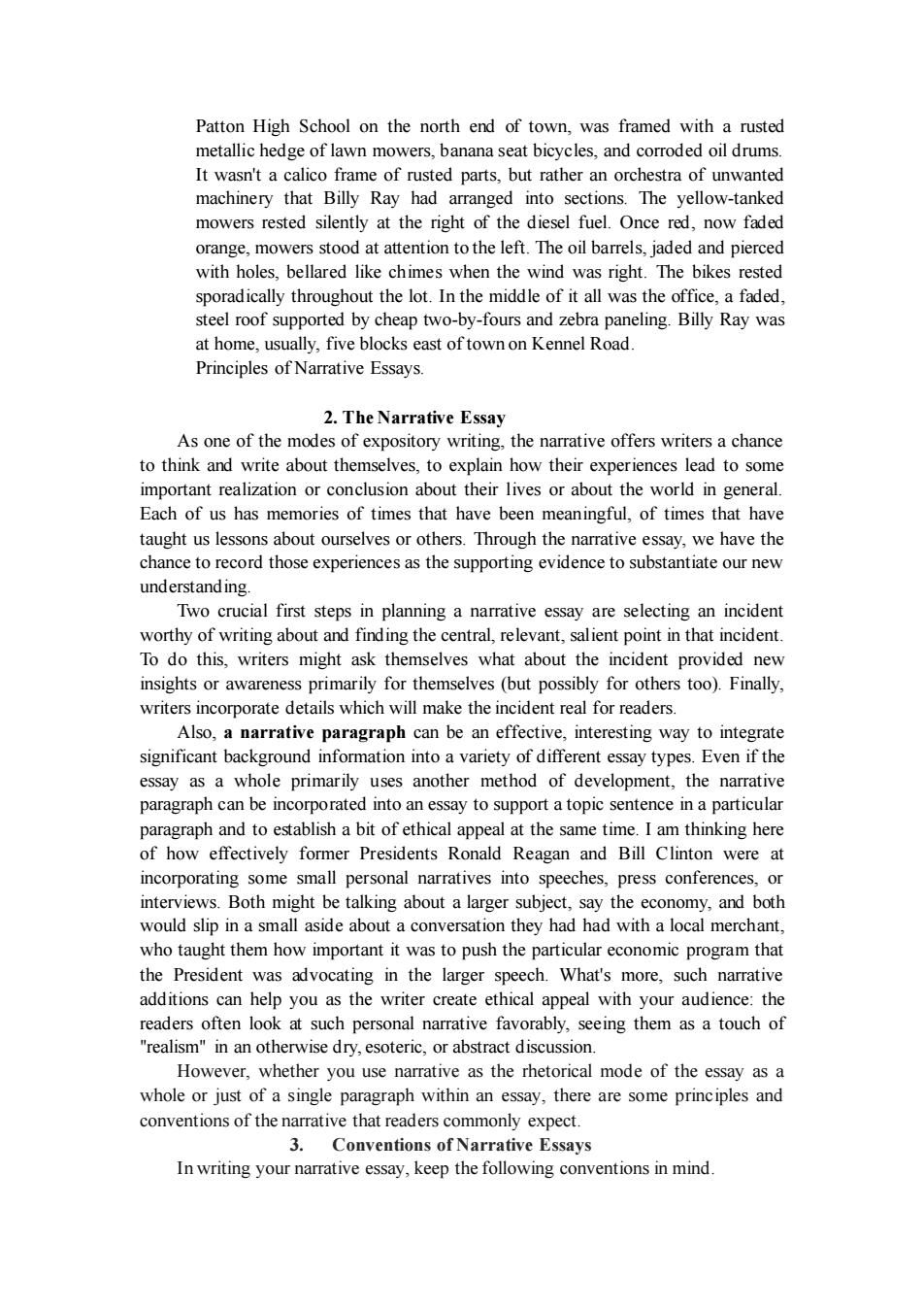
Patton High School on the north end of town,was framed with a rusted metallic hedge of lawn mowers,banana seat bicycles,and corroded oil drum It wasn't a calico frame of rusted parts,but rather an orchestra of unwanted machinery that Billy Ray had arranged into sections.The yellow-tanked mowers rested silently at the right of the diesel fuel.Once red,now faded orange,mowers stood at attention to the left.The oil barrels,jaded and pierced with bellared like imes when the win was right t.The bikes res sporadically throughout the lot.In the middle of it all was the office,a faded steel roof supported by cheap two-by-fours and zebra paneling.Billy Ray was at home,usually,five blocks east of town on Kennel Road. Principles of Narrative Essavs. 2.The Narrative Essay As one of the modes of expository writing,the narrative offers writers a chance to think and write about themselves.to explain how their experiences lead to some important realization or conclusion about their lives or about the world in general. Each of us has memories of times that have been meaningful,of times that have taught us lessons bout ourselves or others.Through the narrative essay,we have the chance to record those experiences as the supporting evidence to substantiate our new understanding. Two crucial first steps in planning a narrative essay are selecting an incident worthy of writing about and finding the central,relevant,salient point in that incident. To do this,writers might ask them selves what about nt incid insights or awareness primarily for themselves(but possibly for others too).Finally writers incorporate details which will make the incident real for readers. Also,a narrative paragraph can be an effective,interesting way to integrate significant background information into a variety of different essay types.Even if the sav as a whole primarily use sanother method of developm the narrativ paragraph can be e inc porate paragraph and to establish a bit of ethical appeal at the same time.I am thinking here of how effectively former presidents ronald reagan and Bill clinton were at incorporating some small personal narratives into speeches.press conferences.or interviews.Both might be talking about a larger subject,say the economy,and both ould slip aside ao nvers n they hadhad with a a local mer cha who taught them how important it was to push the particular economic program tha the President was advocating in the larger speech.What's more.such narrative additions can help you as the writer create ethical appeal with your audience:the readers often look at such personal narrative favorably,seeing them as a touch of ise dry.e oter or abst ract disc sio However whether you use narrative as the rhetorical mode of the essay as whole or just of a single paragraph within an essay,there are some principles and conventions of the narrative that readers commonly expect. 3.Conventions of narrative essavs In writing your narrative essay,keep the following conventions in mind
Patton High School on the north end of town, was framed with a rusted metallic hedge of lawn mowers, banana seat bicycles, and corroded oil drums. It wasn't a calico frame of rusted parts, but rather an orchestra of unwanted machinery that Billy Ray had arranged into sections. The yellow-tanked mowers rested silently at the right of the diesel fuel. Once red, now faded orange, mowers stood at attention to the left. The oil barrels, jaded and pierced with holes, bellared like chimes when the wind was right. The bikes rested sporadically throughout the lot. In the middle of it all was the office, a faded, steel roof supported by cheap two-by-fours and zebra paneling. Billy Ray was at home, usually, five blocks east of town on Kennel Road. Principles of Narrative Essays. 2. The Narrative Essay As one of the modes of expository writing, the narrative offers writers a chance to think and write about themselves, to explain how their experiences lead to some important realization or conclusion about their lives or about the world in general. Each of us has memories of times that have been meaningful, of times that have taught us lessons about ourselves or others. Through the narrative essay, we have the chance to record those experiences as the supporting evidence to substantiate our new understanding. Two crucial first steps in planning a narrative essay are selecting an incident worthy of writing about and finding the central, relevant, salient point in that incident. To do this, writers might ask themselves what about the incident provided new insights or awareness primarily for themselves (but possibly for others too). Finally, writers incorporate details which will make the incident real for readers. Also, a narrative paragraph can be an effective, interesting way to integrate significant background information into a variety of different essay types. Even if the essay as a whole primarily uses another method of development, the narrative paragraph can be incorporated into an essay to support a topic sentence in a particular paragraph and to establish a bit of ethical appeal at the same time. I am thinking here of how effectively former Presidents Ronald Reagan and Bill Clinton were at incorporating some small personal narratives into speeches, press conferences, or interviews. Both might be talking about a larger subject, say the economy, and both would slip in a small aside about a conversation they had had with a local merchant, who taught them how important it was to push the particular economic program that the President was advocating in the larger speech. What's more, such narrative additions can help you as the writer create ethical appeal with your audience: the readers often look at such personal narrative favorably, seeing them as a touch of "realism" in an otherwise dry, esoteric, or abstract discussion. However, whether you use narrative as the rhetorical mode of the essay as a whole or just of a single paragraph within an essay, there are some principles and conventions of the narrative that readers commonly expect. 3. Conventions of Narrative Essays In writing your narrative essay, keep the following conventions in mind
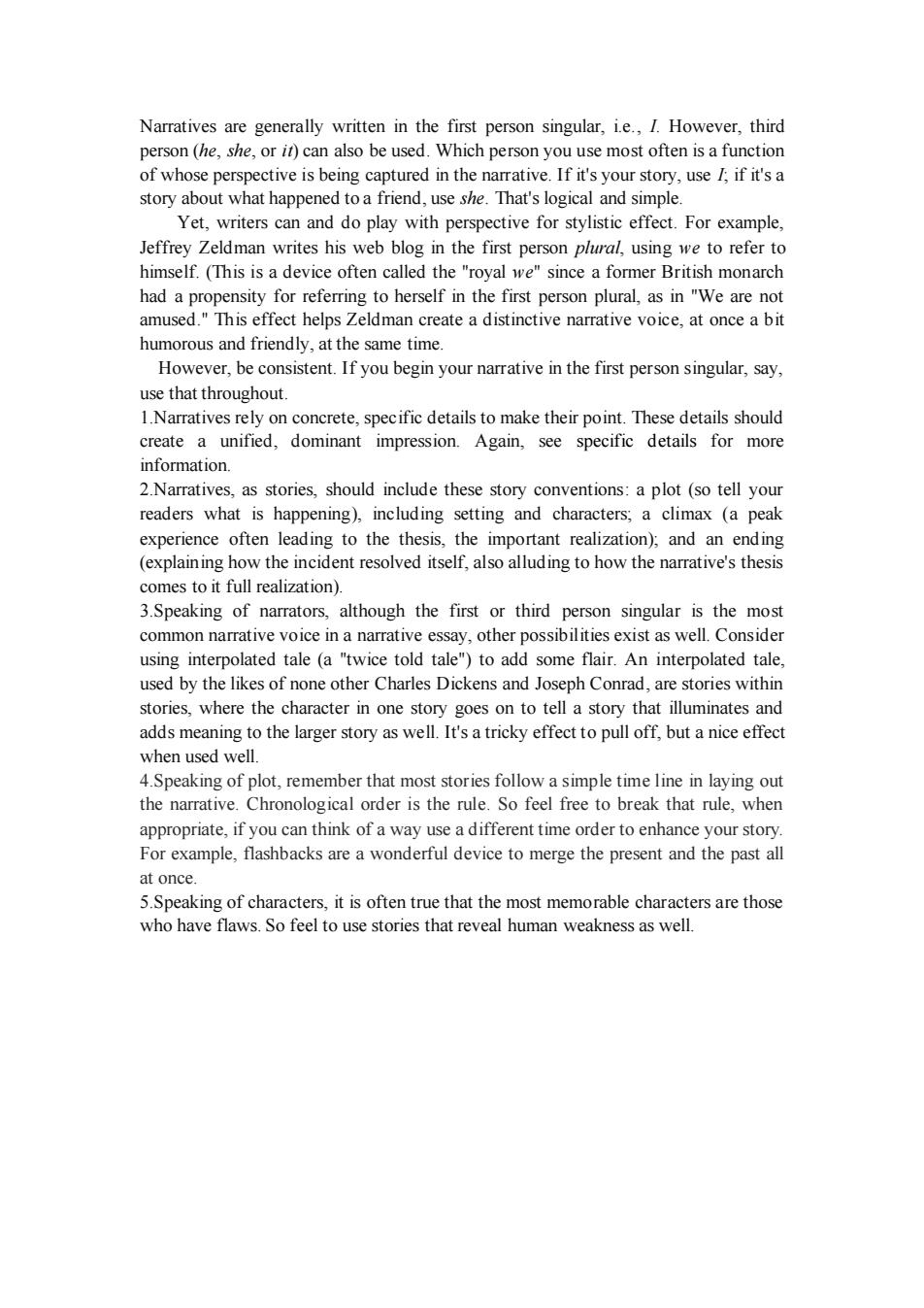
Narratives are generally written in the first person singular,i.e.,I.However,third person (he,she,or it)can also be used.Which person you use most often is a function of whose perspective is being captured in the narrative.If it's your story,use I;if it's a story about what happened to a friend,use she.That's logical and simple. Yet,writers can and do play with perspective for stylistic effect.For example, Jeffrey Zeldman writes his web blog in the first person plural,using we to refer to himself.(This is a device often called the "royal we"since a former British monarch had a propensity for referring to herself in the first person plural,as in "We are not amused."This effect helps Zeldman create a distinctive narrative voice,at once a bit humorous and friendly,at the same time. However,be consistent.If you begin your narrative in the first person singular,say, use that throughout. 1.Narratives rely on concrete,specific details to make their point.These details should create a unified,dominant impression.Again,see specific details for more information. 2.Narratives,as stories,should include these story conventions:a plot (so tell your readers what is happening),including setting and characters;a climax (a peak experience often leading to the thesis,the important realization);and an ending (explaining how the incident resolved itself,also alluding to how the narrative's thesis comes to it full realization). 3.Speaking of narrators,although the first or third person singular is the most common narrative voice in a narrative essay,other possibilities exist as well.Consider using interpolated tale (a "twice told tale")to add some flair.An interpolated tale, used by the likes of none other Charles Dickens and Joseph Conrad,are stories within stories,where the character in one story goes on to tell a story that illuminates and adds meaning to the larger story as well.It's a tricky effect to pull off,but a nice effect when used well. 4.Speaking of plot,remember that most stories follow a simple time line in laying out the narrative.Chronological order is the rule.So feel free to break that rule,when appropriate,if you can think of a way use a different time order to enhance your story For example,flashbacks are a wonderful device to merge the present and the past all at once. 5.Speaking of characters,it is often true that the most memorable characters are those who have flaws.So feel to use stories that reveal human weakness as well
Narratives are generally written in the first person singular, i.e., I. However, third person (he, she, or it) can also be used. Which person you use most often is a function of whose perspective is being captured in the narrative. If it's your story, use I; if it's a story about what happened to a friend, use she. That's logical and simple. Yet, writers can and do play with perspective for stylistic effect. For example, Jeffrey Zeldman writes his web blog in the first person plural, using we to refer to himself. (This is a device often called the "royal we" since a former British monarch had a propensity for referring to herself in the first person plural, as in "We are not amused." This effect helps Zeldman create a distinctive narrative voice, at once a bit humorous and friendly, at the same time. However, be consistent. If you begin your narrative in the first person singular, say, use that throughout. 1.Narratives rely on concrete, specific details to make their point. These details should create a unified, dominant impression. Again, see specific details for more information. 2.Narratives, as stories, should include these story conventions: a plot (so tell your readers what is happening), including setting and characters; a climax (a peak experience often leading to the thesis, the important realization); and an ending (explaining how the incident resolved itself, also alluding to how the narrative's thesis comes to it full realization). 3.Speaking of narrators, although the first or third person singular is the most common narrative voice in a narrative essay, other possibilities exist as well. Consider using interpolated tale (a "twice told tale") to add some flair. An interpolated tale, used by the likes of none other Charles Dickens and Joseph Conrad, are stories within stories, where the character in one story goes on to tell a story that illuminates and adds meaning to the larger story as well. It's a tricky effect to pull off, but a nice effect when used well. 4.Speaking of plot, remember that most stories follow a simple time line in laying out the narrative. Chronological order is the rule. So feel free to break that rule, when appropriate, if you can think of a way use a different time order to enhance your story. For example, flashbacks are a wonderful device to merge the present and the past all at once. 5.Speaking of characters, it is often true that the most memorable characters are those who have flaws. So feel to use stories that reveal human weakness as well